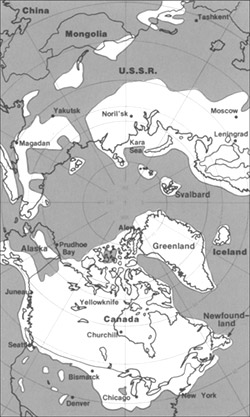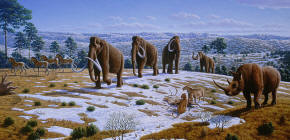Dating
The Pleistocene has been dated from 2.588 million (±5,000 years) to 12,000 years
 |
| Extent of ice coverage in the Northern Hemisphere during the Pleistocene. |
In 2009 the International Union of Geological Sciences (IUGS) confirmed a change in time period for the Pleistocene, changing the start date from 1.8 to 2.588 million years BP, and accepted the base of the Gelasian Stage as the base of the Pleistocene.
The Pleistocene covers the recent period of repeated glaciations. The name Plio-Pleistocene has in the past been used to mean the last ice age. The revised definition of the Quaternary, by pushing back the start date of the Pleistocene to 2.58 Ma, results in the inclusion within the Pleistocene of all the recent repeated glaciations.
Paleogeography and Climate
The modern continents were essentially at their present positions during the Pleistocene, the plates upon which they sit probably having moved no more than 100 km relative to each other since the beginning of the period.
According to one study, the Pleistocene's overall climate could be characterized as a continuous El Niño with trade winds in the south Pacific weakening or heading east, warm air rising near Peru, warm water spreading from the west Pacific and the Indian Ocean to the east Pacific, and other El Niño markers.
Fauna
Both marine and continental faunas were essentially modern.
The severe climatic changes during the ice age had major impacts on the fauna and
 |
| Pleistocene of Siberia showing woolly mammoth, cave lions eating a reindeer, tarpans, and woolly rhinoceros. (Picture Source and credits) |
The extinctions were especially severe in North America where native horses and camels were eliminated.
Humans During the Pleistocene
Scientific evidence indicates that humans evolved (God completed their evolution, or finished creating new species of humans) into their present form during the Pleistocene. In the beginning of the Pleistocene Paranthropus species are still present, as well as early human ancestors, but during the lower Palaeolithic they disappeared, and the only hominid species found in fossilic records is Homo erectus for much of the Pleistocene. This species migrated through much of the old world, giving rise to many variations of humans. The Middle and late Palaeolithic saw the appearance of new types of humans, as well as the development of more elaborate tools than found in previous eras.
While the ultimate “African Origin” view of hominid evolution has not been challenged, some researchers have posited that the last great expansion did not eliminate pre-existing populations of hominids so much as assimilate them upon contact with Homo sapiens. While this would suggest that modifications in modern man may have been extensive and regionally based, the theory remains controversial and has generally lost ground over the past century, due to the advent of genetic evidence that directly contradicts it in favor of a single-origin theory.
Deposits
Pleistocene non-marine sediments are found primarily in fluvial deposits, lakebeds, slope and loess deposits as well as in the large amounts of material moved about by glaciers. Less common are cave deposits, travertines and volcanic deposits (lavas, ashes). Pleistocene marine deposits are found primarily in shallow marine basins mostly (but with important exceptions) in areas within a few tens of kilometers of the modern shoreline. In a few geologically active areas such as the Southern California coast, Pleistocene marine deposits may be found at elevations of several hundred meters.
End of Reading
Return to the Old Earth Ministries Online Earth History Curriculum homepage.
Source: Pleistocene Epoch